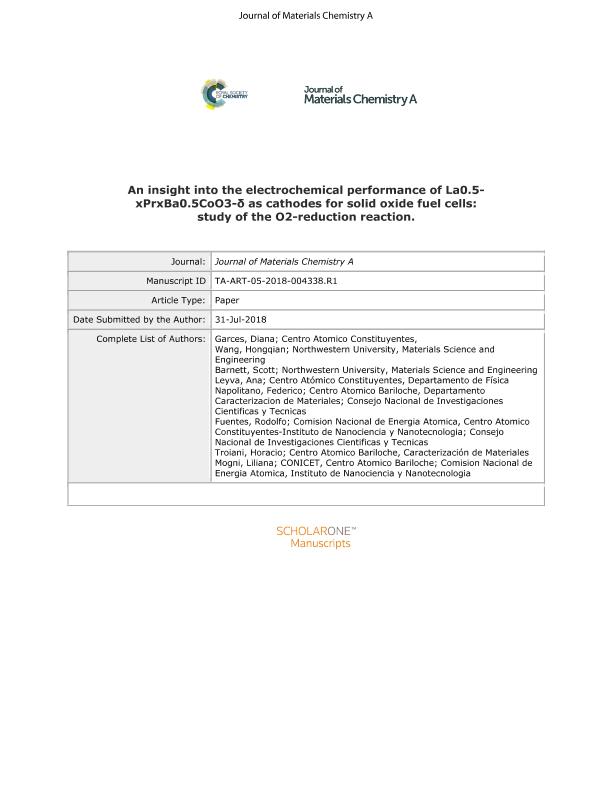Artículo
An insight into the electrochemical performance of La0.5-XPrxBa0.5CoO3- δ as cathodes for solid oxide fuel cells: Study of the O2-reduction reaction
Garcés, D.; Wang, H.; Barnett, S.A.; Leyva, Adelma Graciela ; Napolitano, Federico Ricardo
; Napolitano, Federico Ricardo ; Fuentes, Rodolfo Oscar
; Fuentes, Rodolfo Oscar ; Troiani, Horacio Esteban
; Troiani, Horacio Esteban ; Mogni, Liliana Verónica
; Mogni, Liliana Verónica
 ; Napolitano, Federico Ricardo
; Napolitano, Federico Ricardo ; Fuentes, Rodolfo Oscar
; Fuentes, Rodolfo Oscar ; Troiani, Horacio Esteban
; Troiani, Horacio Esteban ; Mogni, Liliana Verónica
; Mogni, Liliana Verónica
Fecha de publicación:
08/2018
Editorial:
Royal Society of Chemistry
Revista:
Journal of Materials Chemistry A
ISSN:
2050-7488
e-ISSN:
2050-7496
Idioma:
Inglés
Tipo de recurso:
Artículo publicado
Clasificación temática:
Resumen
New LT-SOFC cathodes with La0.5-xPrxBa0.5CoO3-δ (0 ≤ x ≤ 0.5) compositions were studied. The La-rich compounds exhibit an inter-growing cubic and tetragonal structure whereas the Pr-rich show a tetragonal structure. Cathode polarization resistances, estimated from electrochemical impedance (EIS), take values around 0.15 and 0.04 Ω cm2 in air at 600 and 700 °C, respectively. The O2-reduction mechanism and its kinetic coefficients, O-ion diffusion (Dchem) and O-surface exchange (kchem), were studied by applying the ALS model for macro homogenous porous electrodes to the EIS data, in combination with microstructural parameters obtained from three-dimensional tomography using focused ion beam-scanning electron microscopy (3D FIB-SEM). The diffusion coefficients for samples with mixing of phases take values of Dchem ∼ 10-6 cm2 s-1, at 700 °C in air, whereas the pure tetragonal phases present lower values Dchem ∼ 10-8 cm2 s-1. On the contrary the kchem for all samples takes values ranging between 0.4 and 1 × 10-4 cm s-1 at 700 °C in air. In addition, the origin of time evolution of polarization at 700 °C in air was evaluated by combining the EIS spectra as a function of time and the ex situ sample characterization of fresh and tested samples by 3D FIB-SEM tomography and inductively coupled plasma-optical emission spectrometry (ICP-OES). Little changes of microstructures were detected, whereas an increasing of the amount of a water-soluble Ba surface species in comparison with total cation surface segregation was observed for all samples after the ageing. This may constitute the main reason causing the polarization resistance degradation. However, the analysis of time evolution shows, that contrary to the situations reported for SrO segregation in Sr-based perovskites, the Dchem is the coefficient mainly affected for compositions with inter-grown phases. At the same time, both Dchem and kchem decreases with time when only the tetragonal phase is present.
Palabras clave:
IT-SOFC
,
cathode
,
degradation
,
FIB-SEM
Archivos asociados
Licencia
Identificadores
Colecciones
Articulos(CCT - PATAGONIA NORTE)
Articulos de CTRO.CIENTIFICO TECNOL.CONICET - PATAGONIA NORTE
Articulos de CTRO.CIENTIFICO TECNOL.CONICET - PATAGONIA NORTE
Articulos(OCA CIUDAD UNIVERSITARIA)
Articulos de OFICINA DE COORDINACION ADMINISTRATIVA CIUDAD UNIVERSITARIA
Articulos de OFICINA DE COORDINACION ADMINISTRATIVA CIUDAD UNIVERSITARIA
Articulos(UE-INN)
Articulos de UNIDAD EJECUTORA INSTITUTO DE NANOCIENCIA Y NANOTECNOLOGIA
Articulos de UNIDAD EJECUTORA INSTITUTO DE NANOCIENCIA Y NANOTECNOLOGIA
Citación
Garcés, D.; Wang, H.; Barnett, S.A.; Leyva, Adelma Graciela; Napolitano, Federico Ricardo; et al.; An insight into the electrochemical performance of La0.5-XPrxBa0.5CoO3- δ as cathodes for solid oxide fuel cells: Study of the O2-reduction reaction; Royal Society of Chemistry; Journal of Materials Chemistry A; 6; 34; 8-2018; 16699-16709
Compartir
Altmétricas



